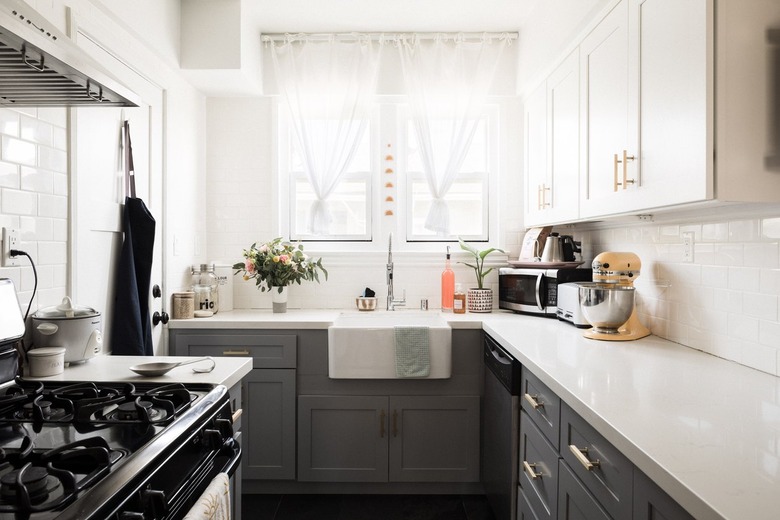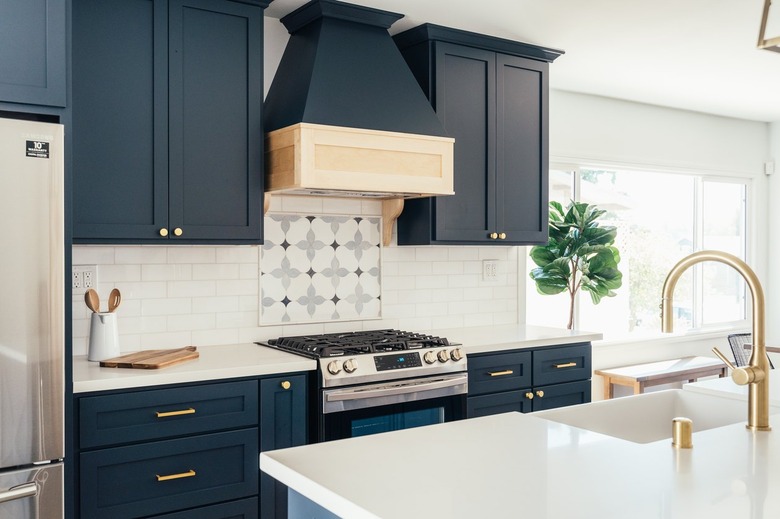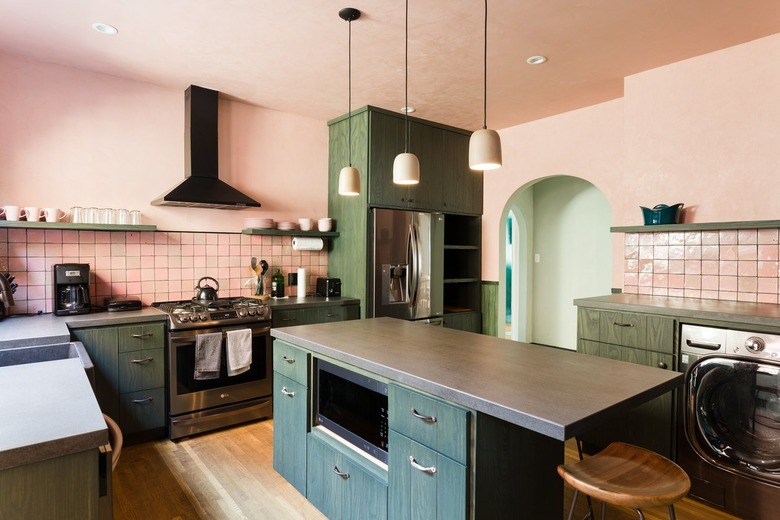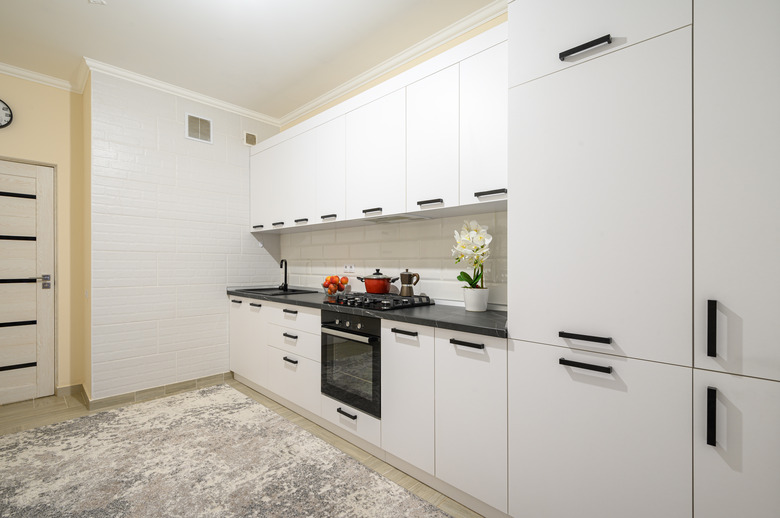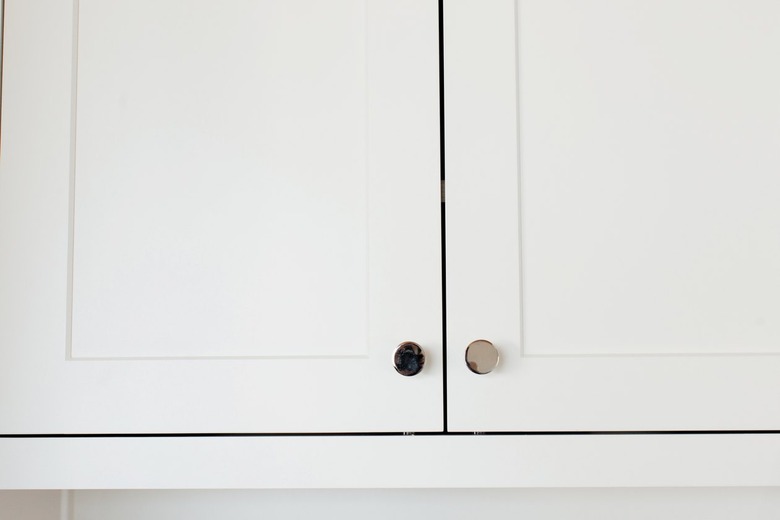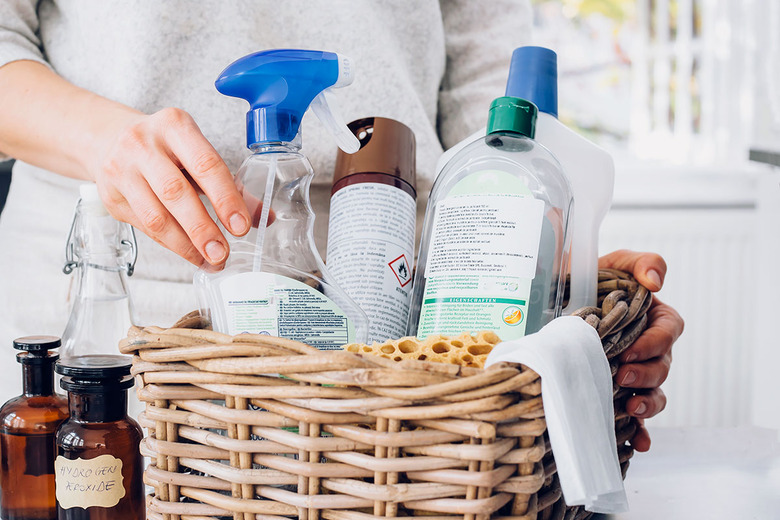How To Clean Kitchen Cabinets In A Few Easy Steps
We may receive a commission on purchases made from links.
It doesn't take a professional chef to know just how much action kitchen cabinets see. Whether your cook space is modern, rustic, Scandi, or industrial, no doubt the cabinets are one of the hardest-working elements. From storing spices and oils, pantry staples, and pots and pans, they are opened and closed repeatedly and their insides (and outsides) get a real workout. But for most people, the truth is that while mopping floors and wiping down countertops are generally part of a daily cleaning routine, cabinet cleaning is often overlooked.
Aside from the unappealing look of fingerprints, smudges, grease splatter, and spills, dirty cabinets actually pose a health hazard — they allow potentially harmful bacteria to grow, which can make you and your family sick. Plus, the build-up of grime can eventually damage the paint. But have no fear, regular cleaning will preserve the integrity of your cabinets, allowing them to look better and last longer.
The Do's and Don'ts of Cleaning Cabinets
The Do's and Don'ts of Cleaning Cabinets
Before you roll up your sleeves and get down to the business of cleaning your cabinets, make sure you're prepared with the following supplies that'll help you tackle the job.
Do Start at the Top and Work Your Way Down
For quarterly deep cleans, remove everything (yes, everything). This a great time to check expiration dates, toss anything old, and give bottles and cans a wipe. For tougher stains, test stronger cleaning solutions in a concealed area before using them on cabinet fronts. Stay on top of spills and implement a regular cleaning schedule to streamline the process.
Don't Use Abrasive Cleaners
There's more than one way to clean kitchen cabinets. The best products for the task depend on the type of mess — food splatters or grime will require something a bit stronger than dusting — and how long the mess has been there. The finish of the cabinets is also a factor. Stay away from abrasive and toxic cleaners for all cabinet types. Don't oversaturate cabinets or hinges — a little cleaner goes a long way. The one factor that holds true for any mess on or in a kitchen cabinet is this: The sooner you clean it, the easier the process is going to be.
Things Needed
How to Clean Kitchen Cabinets
How to Clean Kitchen Cabinets
The right method for cleaning your kitchen cabinets depends on the type of cabinets you have.
References
How to Clean Glass-Front Cabinets
Glass-front cabinets break up the monotony and heaviness of a wall of closed storage while also creating the illusion of depth and reflecting light. True, they're magnets for dirt and fingerprints, but they're relatively easy to maintain and keep clean with a vinegar mixture or commercial glass cleaner.
Spray a microfiber towel and wipe the glass on both the inside and outside of the cabinet. Dried splatters, grease, and other food-related build-up is easy to remove but might require a double pass to completely eliminate. Again, stay away from abrasive cleaners as they can scratch the glass. For the rest of the cabinet, wipe down with a damp cloth and warm water.
How to Clean Wood Cabinets
The finish on the average wood cabinet offers a durability that protects the wood and makes it relatively easy to clean for typical food messes and routine care. However, even with a quality sealant on the cabinets, it's best to use mild cleaning products on wood and stay away from harsh chemicals.
Also, avoid using harsh abrasives such as rough steel-wool pads that may scratch the cabinets. Oil soap or even dish soap works well for general wood cabinet cleaning.
- Mix Murphy Oil Soap in a bucket of clean, hot water, following recommendations on the product packaging. If you are using dish soap, a drop or two of dish soap per half gallon of water does the trick.
- Dip a lint-free cloth or sponge into the liquid, wring it out, and then clean the kitchen cabinets from the top down.
- Wipe them again with another damp cloth containing just water.
- Follow up by wiping the cabinets dry. This helps keep excess moisture from soaking through the finish or paint and into the wood.
- For wood cabinets with an old, dull finish that used to be clear and bright, mineral spirits may help refresh the appearance while removing stubborn grease and grime without causing damage. Open the windows and turn on fans before using mineral spirits on the finish, as the odor is strong. Test an area such as the inside of a cabinet door by wiping it down with a lint-free, white cloth dipped into mineral spirits. Most clear finishes will not be harmed by mineral spirits, but it is always best to test them first. If you like the results, wipe down the entire finished exterior of each cabinet with the mineral spirits and then buff them with a dry, lint-free cloth.
How to Clean Painted Cabinets
To clean kitchen cabinets that have painted surfaces, the safest and most effective method is to wipe down with mild dish soap and warm water. The combo is gentle enough to prevent damage to the paint, no matter the finish. Avoid abrasive cleaners and cloths or sponges. Aim to wipe down your cabinet fronts every other week. If you are faced with stubborn grime, wipe down with a mixture of warm water and a bit of detergent. Then go back and wipe down with non-soapy water, and again with a dry microfiber (or similar) cloth.
How to Clean Laminate Cabinets
Laminate cabinets are usually able to withstand more powerful cleaners and abrasives than the average wood cabinet, although it's always best to start with gentle cleaners as noted in the manufacturer's recommendations. The same holds true with similar surfaces such as melamine and thermofoil.
For general all-over cleaning, dish soap and water will get the job done. For spot cleaning, a multipurpose cleaner comes in handy — or use a paste of baking soda and water. Citrus-oil cleaners work well for removing greasy or gooey messes — just spray the area, or spray some onto a lint-free cloth, and rub the stain from the outside of the mess toward the center. A nylon scouring pad also helps for removing gunk that won't come off with a cloth.
How to Clean Cabinet Hardware
Cabinet hardware is especially prone to getting dirty, as the handles and knobs are touched far more often than other parts of the cabinet. To clean hardware effectively, wipe down knobs and pulls with a soft cloth or sponge dipped in equal parts water and white vinegar. An old toothbrush or nail brush comes in handy for scrubbing grime.
For messes that require a little extra effort, make a paste of baking soda and water. Rub the hardware with a cloth or toothbrush dipped into the paste and then wipe the excess away with a damp cloth. Rinse and wipe down the hardware again.
For grime that's been stuck on the hardware for who-knows-how-long, cleaning is easier if you remove the hardware from the cabinet. In most cases, knobs and pulls can be removed by unscrewing them from the back of the door or drawer front. Try the baking soda paste and a toothbrush; if that doesn't work, a citrus-based grime or adhesive remover will work, too. Mineral spirits may also be used on metal or ceramic handles and knobs.
How to Clean Inside Cabinets
Although a cabinet's exterior bears the brunt of daily activity, the insides are subject to drips, crumbs, and spills and should be periodically cleaned as well. It's best to clean up these messes as soon as they happen and before they have a chance to soak in or harden.
- Remove all of the items stored within the cabinets and then wipe down the inside with a microfiber cloth to remove any dust or stray food.
- Wipe down the inside again with a mix of equal parts vinegar and water applied with a microfiber cloth or a lint-free cloth, such as a cotton tea towel.
- Leave the cabinet doors open until the shelves dry and then replace the items that you usually store inside.
- For stubborn stains, like rings left by spills around a container, use an appropriate cleaning solution, such as a grease-cutting citrus cleaner for a greasy or gummy residue.
Tip
The best way to prevent dirty cabinet interiors is to keep the cabinet doors shut when you've taken out what you need, and to wipe away any drips on bottles before returning them. Use a shelf-lining material on each shelf (such as shelf paper or contact paper) especially for shelves where potential spills may happen, like in a pantry cabinet.
How to Spot-Clean Grime in Cabinets
When one-off spills occur, cabinets won't usually need to be cleaned from top to bottom. A simple spot-cleaning treatment that's appropriate for the mess at hand will do the trick.
A citrus-based adhesive remover helps with more stubborn caked-on messes, such as hardened jelly — just be sure to read the label first to ensure the product is safe for your cabinet surface. If you're unsure, test the product in an inconspicuous area first. You may be able to scrape away the bulk of a hardened substance with a plastic scraper or the bowl of a plastic spoon without damaging the cabinet surface, but this is safer to try on the inside of a cabinet.
Use your preferred cleaning product to remove any remaining residue and then wipe the area again with a damp cloth. Avoid solutions with bleach or other harsh chemicals that could discolor cabinet surfaces.
